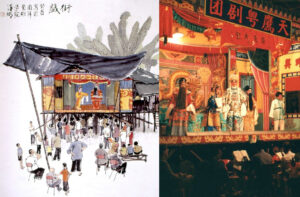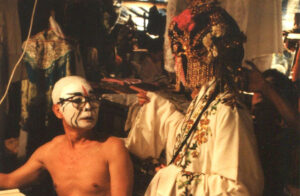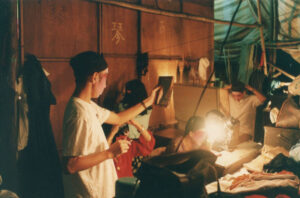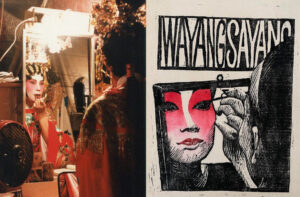On the week of 3 December 2023, artist Ming Wong took over The Everyday Museum’s Instagram account to share his reflections on how Chinese opera has profoundly influenced his artistic practice. This takeover was in conjunction with the move of his public art commission Wayang Spaceship from Singapore Art Museum at Tanjong Pagar Distripark to Empress Lawn, in front of Victoria Theatre and Concert Hall, back in January 2024.
Sun, 3 December 2023






The wayang stage was still a common sight when I was growing up in Singapore, especially around religious festivals. I started to visit backstage as research when I was a student at NAFA. Wayang was a subject for my painting practice and also my playwriting in my 20s. Observing the transformations taking place between onstage and backstage was akin to travelling in time and space, between mythological fantasy worlds and the humble human realities of a theatre troupe.
It was fascinating to see the construction (and subsequent deconstruction) of these archetypal characters through the accouterments of the trade: costumes, makeup, headdresses, props, stylised movement, acting, speaking and singing; to witness how the sweating, cursing, mundane everyday backstage activity give way to the creation of an otherworldly performative realm on stage.
—
📷: Images and monoprints of early 90s artworks courtesy of the artist
Mon, 4 December 2023



Chinese street opera came about as troupes traveled around the region to perform for overseas Chinese communities. Not only restricted to Southeast Asia but also around the world, becoming an itinerant transnational performing art form that preserved the circulation of traditional culture and identity. For over a century, the Wayang has kept reappearing out of nowhere, in communion with generations of the local populace, as a constant witness to the multitude of changes in the city and its surroundings.
These pictures could be said to be illustrations of the fantastical journeys explored in the canon of Chinese street operas but projected into another dimension of time and space.
—
📷1-3: Ming Wong, 𝙋𝙞𝙘𝙩𝙪𝙧𝙚𝙨 𝙛𝙧𝙤𝙢 𝙩𝙝𝙚 𝙒𝙖𝙮𝙖𝙣𝙜 𝙎𝙥𝙖𝙘𝙚𝙨𝙝𝙞𝙥, 2023. Images courtesy of the artist
Tue, 5 December 2023


Come January 2024, the 𝘞𝘢𝘺𝘢𝘯𝘨 𝘚𝘱𝘢𝘤𝘦𝘴𝘩𝘪𝘱 will travel from the seaport down to the Singapore River, the heart of the colonial metropolis; the Chinese theatre arrives in Singapore via the South China Sea and encounters the colonial theatre in the Victoria Theatre and Concert Hall, overlooking the Singapore Cricket Club and Supreme Court, now the National Gallery. It thus takes its place amongst these historical monuments, reflecting the history around it by day, before coming alive at sunset, continuing to mark its historical position as a gathering place at the mouth of the Singapore River, the confluence of many perspectives and narratives from many far away places.
—
📷1: Image courtesy of the artist
📷2: Installation view of 𝘞𝘢𝘺𝘢𝘯𝘨 𝘚𝘱𝘢𝘤𝘦𝘴𝘩𝘪𝘱 by Ming Wong (2022).






